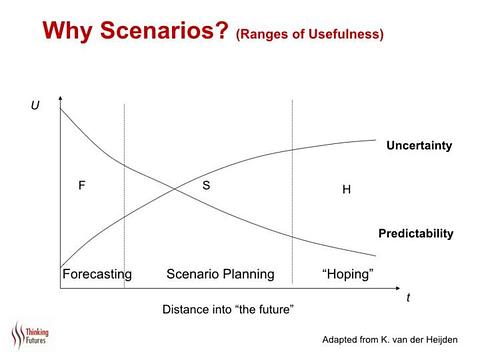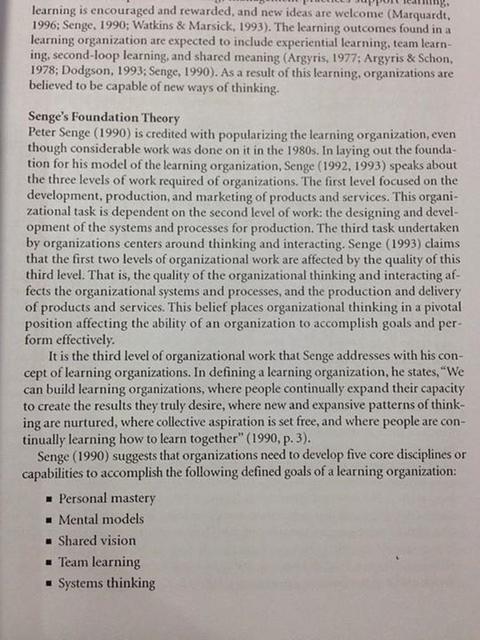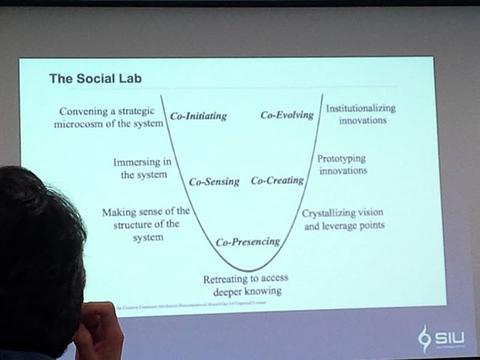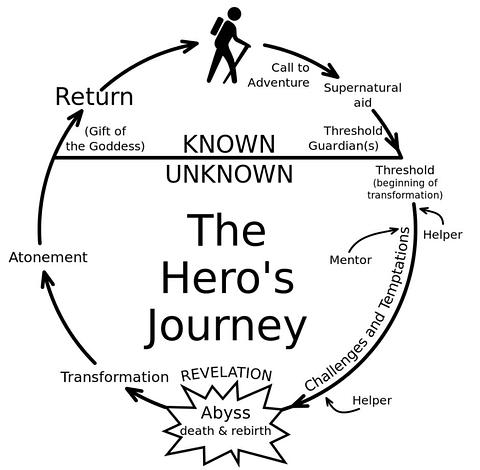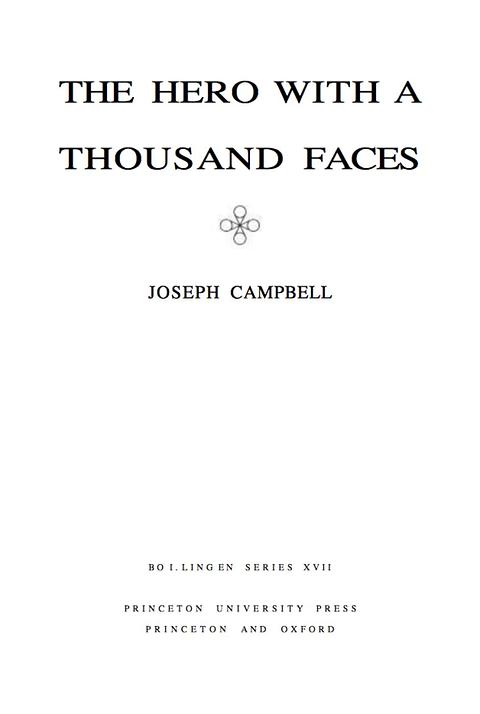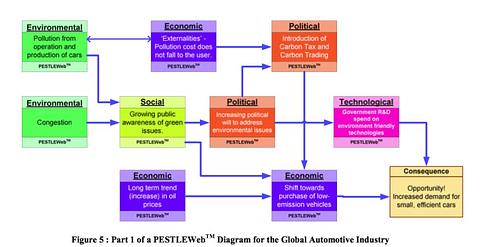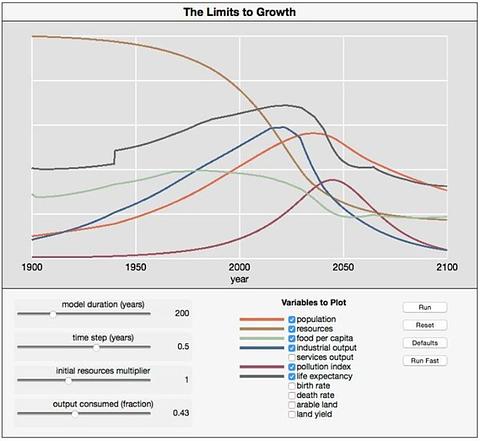Scenario Planning Methodology
Since the emergence of Scenario Planning in military war games and the beginning of the application in civil domain at such think tank as RAND Corporation and Hudson Institute (heavily pioneered by Herman Kahn), I think Royal Dutch Shell has proved the successful of using Scenario Planning in their business.
(ขอบคุณรูปถ่ายและสรุปจากคุณหมอธงชัย
หลักเบื้องต้นในการทำฉากทัศน์ Scenario workshop
(สรุปจากที่เรียนรู้ใน ASEAN Scenario workshop เมื่อวานนี้)
1. ถ้าเรารู้ค่อนข้างแน่นอน ทำนายได้ จะเรียกว่าเป็นการพยากรณ์ (Forcasting) แต่ถ้าเป็นอนาคตที่ไกลออกไปมากขึ้น ความไม่แน่นอนมากขึ้น จะเป็นการทำฉากทัศน์ (Scenario Planning) และถ้าเป็นอนาคคไกลมรากๆ ก็จะเป็นการเดา (Hoping)
2. กระบวนการคุยกัน จะไม่ใช่การคุยแบบฟังแล้วเก็บไว้ (talking nice) หรือ การฟังแบบโต้แย้งไปมา (Talking tough) หรือ การฟังแบบเห็นอกเห็นใจ (reflective dialogue) แต่ให้พยายามข้ามไปเป็นการฟังแบบปัจจุบัน ให้ไหลลื่น (Generative dialogue)
3. ต้องคุยกันให้มากไปกว่าการคุยปรากฎการณ์(Events) ที่เกิดขึ้น หรือคุยเฉพาะรูปแบบที่เกิดขึ้นซ้ำๆ (Patterns) แต่ให้คุยลึกลงไปถึงใต้ภูเขาน้ำแข็ง ส่วนที่เป็นโครงสร้าง (Structures) ของปรากฎการณ์นั้นๆ และถ้าทำได้ก็จะคุยไปถึงฐานคิด (Mental models) ของเรื่องนั้น
4. การสร้างฉากทัศน์ ต้องอาศัยคนที่เกี่ยวข้องกับเรื่องนั้นๆ มาเข้าร่วมกระบวนการ แต่ละคนจะมีความเห็นที่แตกต่างกันหลายมุมมอง ดังนั้นจะใช้ U-process หรือการทำ Social lab โดยเริ่มจาก Co-initiating ที่สร้างความตั้งใจร่วมกัน ลงลึกไปที่ Co-sensing โดยการสังเกตฟังทั้งเสียงภายในจิตใจตนเอง ลงลึกสุดที่ Co-presencing เชื่อมกับ inner ของตนเอง จนเกิดความรู้ผุดบังเกิด จากนั้นจะเป็นขาขึ้นที่จะสร้าง Co-creating และ Co-evolving ได้ innovation ออกมา
5. ใช้ STEEP model คือ แยกดูเป็น 5 ด้าน คือ สังคม Societal เทคโนโลยี Technology เศรษฐกิจ Economy สิ่งแวดล้อม Environment และ การเมือง Politics
ส่วนกระบวนการจะทำอะไรบ้างไว้มาเล่าให้ฟังครับ
ขอบคุณ SIU และพี่โด่ง Suntariya Muanpawong มากครับที่ให้โอกาสเรียนรู้)
In 1972, with Scenario Planning methodology, Shell had correctly identified the forming of OPEC, oil crisis in the winter of 1973-1974, and the declining of oil price in 1986. The proprietary Shell regional scenario with the topic of "The Greening of Russia" had identified of the collapse of Soviet Union and the chaos in Easter Europe after that. It has even identified the rising of Islamic radicalism and the increasing of pressure on environmental and social issues.
Forbes used to report Shell as the worse performance company in "Seven Sisters" of the international oil industry in 1970. But since 1979, with this new methodology (at that time), Shell has emerged from the weakest of the "Seven Sisters" as the strongest one. Forbes had ranked Shell at top 50 of international business in term of revenue, assets, and market value.
The Transformative Scenario Planning
After Pierre Wack, Kees van der Heijden, a dutch economist had joined as the chief of the scenario department, and then Joseph Jaworski in 1990. Adam Kahane had joined Shell at 1988, and he had been dispatched to South Africa as the head of Mont Fleur scenario project in 1991. Pieter le Roux, the left leaning intellectual had phoned Jaworski and Kahane asking for help the opposition (ANC) to build the scenario after the releasing of Nelson Mandela and endorsing the general election .
U.Lab & Otto Scharmmer
Shell Scenario : http://www.shell.com/global/future-energy/scenario...
The passion of Jaworski to pursue the "desired" scenario, rather than stay away from the "happening" scenarios in Shell 1992 scenario , the idea of "transformative scenario" has emerged ever since. Although both Jaworski and Kahane quit Shell to start their own consulting business, Generon Consulting, together with Bill O'Brein (from Hanover Insurance) and Otto Scharmer. It seemed they have separated from each other. Jaworski has built Generon International , Kahane to build Reos Partner , and Scharmer to build the concept of "Theory U".
Recommended Scenario Planning books:
- Mandela's way, it doesn't relate to scenario planning. But to remind the reader that it's not only "Montflure Scenario workshop" to play role in the peaceful transformation in South Africa, but also other attempts. One thing is Don E. Beck's invitation by Nelson Mandela to study on spiral dynamics. "He worked with F. W. de Klerk, Nelson Mandela and John C. Hall, Chairman of South Africa's National Peace Committee, who references Beck’s ongoing (15 years) work in a 1993 interview. This work is detailed in the book The Crucible: Forging South Africa's Future."
- Synchronicity: The Inner Path of Leadership by Joseph Jaworski, Jaworski includes his experience at Shell in this book too.
- Solving Tough Problems: An Open Way of Talking, Listening, and Creating New Realities by Adam Kahane, this book and Jaworski's have been written on the forward by Peter Senge.
- Power and Love: A Theory and Practice of Social Change by Adam Kahane. Kahane has included his experience in including the contradicted forces (power & love) in his scenario methodology, plus more experiences on conducting the workshops. (I'd like to call it the "gravity of forces".
- Transformative Scenario Planning: Working Together to Change the Future by Adam Kahane. This is the first time he's tried to conceptualized the U-theory and Scenario Methodology together into the "transformative scenario planning". This book has been forwarded by Kees van der Heijden.
- Scenarios: The Art of Strategic Conversation by Kees van der Heijden. This is the classic text for scenario planning methodology.
Mental Model
Many people have overlooked the importance and impact of Peter Senge to the management science nowadays. May be his name has not been heard widely like such business guru as Peter Drucker, Philip Kotler and Michael E Porter.
But his book, "The fifth discipline: the art & practice of the learning organization" has marked the pinpoint on "learning organization" concept and has brought this idea into organization development and human resource development realm (Senge).
He has mentioned "mental model" as one of the five disciplines in the "learning organization". Again, it's quite difficult to explain the meaning of this keyword. But it reflects the foundation of our thinking and worldview. Because it isn't a reality but a model, (thinking about tube map that it needs not to reflect the real distance of each substation, but to give the information of a connection of stations in the network of the tube.) So, sometimes people just get stuck on the specific "mental model", believing it as a truth and thus unable to perceive the dynamism of reality. An actually, the culture, norm and language can also shape the "mental model". This essay has reviewed the history of the concept of "mental model" . (read more information at mental model blog)
In the “Five Discipline” book, Senge has mentioned the "scenario planning" at the Royal Dutch Shell. He is well aware on how "mental model" has played a very important role in the decision making process:
In principle, Shell's "Group Planning" staffs were in an ideal position to disseminate insights about the changes ahead. Group Planning was the central planning department, responsible for coordinating planning activities in operating companies worldwide. At the time, Group Planning was developing scenario planning as a practical method for summarizing alternative future trends. The planners at Shell began to build the coming discontinuities into their scenarios. But their audience of Shell managers found these new scenarios. But their audience of Shel managers found these new scenarios so contradictory to their years of experience with predictable growth that they paid little attention to them.
At this point, Wack and his colleagues realized that they had fundamentally misperceived their task. In a famous Harvard Business Review article he wrote over a decade later, Wack said that, from that moment, "We no longer saw our task as producing a documented view of the future... Our real target was the 'microcosms' our decision makers .. Unless we influenced the mental image, the picture of reality held by critical decision-makers, our scenarios would be like water on a stone.
The influence of Senge's idea on organization development & human resource development. (Foundations of Human Resource Development by Richard A Swanson & Elwood F Holton III, pp. 173)
Precensing concept
It's hard to explain the status of the word "presensing" (present + sensing) and "generative dialogue". But I'd like to borrow what Otto Scharmer explained about Placido Domingo singing of "No puede ser" in his presentation about "Theory U".
Watching this video clip, you'll sense the "change of the movement" at around 2.20, and then "the tipping point" was at 2.35 when the conductor looked at Placido Domingo. The conductor then dropped his baton at 2.42, it was Otto's interpretation as "the radical symbolic" of the conductor (his pride is the handle of baton). It means that he forgot the "self" (seeing yourself as the part of the whole system), and beginning the sensing of himself, the singer, and the whole band in preparing to move to the maxim. At the moment it's the presencing on emerging collective creativity. At the end of this performance, you'll feel the intense of such co-creative work from all of them.
No puede ser
¡No puede ser! Esa mujer es buena.
¡No puede ser una mujer malvada!
En su mirar, como una luz singular,
he visto que esa mujer es una desventurada.
No puede ser una vulgar sirena
que envenenó las horas de mi vida.
¡No puede ser! Porque la vi rezar,
porque la vi querer,
porque la vi llorar.
Los ojos que lloran no saben mentir;
las malas mujeres no miran así.
Temblando en sus ojos dos lágrimas vi
y a mí me ilusiona que tiemblen por mí,
que tiemblen por mí.
Viva luz de mi ilusión,
sé piadosa con mi amor,
porque no sé fingir,
porque no sé callar,
porque no sé vivir.
...
It cannot be so
It cannot be so! This woman is good.
She cannot be a wicked woman!
In her look, like a strange light,
I've seen that this woman is unhappy.
She cannot be a cheap siren
who poisoned every moment of my life.
It cannot be so! Because I've seen her pray,
because I've seen her love,
because I've seen her cry!
Those eyes that cry don't know how to lie.
Bad women do not look like that.
Gleaming in her eyes I saw two tears,
and my hope is they may gleam for me,
they may gleam for me.
Vivid light of my hopes
Be merciful with my love
Because I cannot pretend,
because I cannot be silent,
because I cannot live!
Monomyth
The idea of Presencing has been developed from the "hero's journey" (Monomyth storyline)
Among the "Monomyth" storyline (see https://en.wikipedia.org/wiki/Monomyth ), I think I like Total Recall 2012 the most, so far. It has been modified from the former version of 1990 film. But I like this version more, the waking up of protagonist and turning himself to be a deadly (double) secret agent with implanting memory company, Rekalls.
But I think the "real" wake up is at this scene, the scene of playing piano in Beethoven Tempest, 3rd Movement.
According to Monomyth, the adventure of hero into strange world, fighting with difficulties alone or with helps, he can return home with great gift if survive. You can read this from Joseph Campbell's The Hero with a Thousand Faces. (Star Wars has been written by the influence of this book.)
Campbell has found that all the human being's myths have similar pattern of storyline:
The mythological hero, setting forth from his common-day hut or castle, is lured, carried away, or else voluntarily proceeds, to the threshold of adventure. There he encounters a shadow presence that guards the passage. The hero may defeat or conciliate this power and go alive into the kingdom of the dark (brother-battle, dragon-battle; offering, charm), or be slain by the opponent and descend in death (dismemberment, crucifixion). Beyond the threshold, then, the hero journeys, through a world of unfamiliar yet strangely intimate forces, some of which severely threaten him (tests), some of which give magical aid (helpers). When he arrives at the nadir of the mythological round, he undergoes a supreme ordeal and gains his reward. The triumph may be represented as the hero’s sexual union with the goddess-mother of the world (sacred marriage), his recognition by the father-creator (father atonement), his own divinization (apotheosis), or again - if the powers have remained unfriendly to him - his theft of the boon he came to gain (bride-theft, fire-theft); intrinsically it is an expansion of consciousness and therewith of being (illumination, transfiguration, freedom). The final work is that of the return. If the powers have blessed the hero, he now sets forth under their protection (emissary); if not, he flees and is pursued (transformation flight, obstacle flight). At the return threshold the transcendental powers must remain behind; the hero re-emerges from the kingdom of dread (return, resurrection). The boon that he brings restores the world (elixir). (p.227 - 228)
But the hero in Total Recall will walk the adventure with confusing about his own identity and belief. Who he really was in the past, and actually whether he is living in the dream all over the story? This has increased more depth and dimension into the "Monomyth" storyline.
In the end, the past and the future might not as important as in the the present. It doesn't matter the history was, it may be fake or real. Someone may manipulate the history. But in the end, we must live in the world, and make a decision with our heart, on what's genuine.
It may like the meaning from Roman poet Horace's Odes of "Carpe diem".
See this picture from Wikipedia:Monolith, read the whole book from http://www.dabhub.com/datas/media/The Hero wit...
The twelve stages of the hero's journey monomyth following the summary by Christopher Vogler (originally compiled in 1985 as a Disney studio memo): 1. the ordinary world, 2. the call to adventure, 3. refusal of the call, 4. meeting with the mentor, 5. crossing the threshold to the "special world", 6. tests, allies and enemies, 7. approach to the innermost cave, 8. the ordeal, 9. reward, 10. the road back, 11. the resurrection, 12. return with the elixir.
STEEP Model
A STEEP analysis is a tool commonly used in marketing to evaluate different external factors which impact an organization. It is essential for every business to consider some external forces before they can take decisions.
Many people have limited imagination as it is shaped by their own experience and beliefs. This tendency often leads an individual to neglect the reality or to refuse to recognize the critical changes around them. In the world of business, there is immense pressure to take quick decisions and to act on the judgment and instinct instead of careful analysis of the situation.
The STEEP analysis is often conducted by firms to get a detailed overview on what external factors determine the trends. It also helps to predict what might happen in the future. STEEP is basically an acronym which stands for Social, Technological, Economical, Environmental, and Political. It is also known around the world as PEST, PESTEL, PESTLE, STEPJE, STEP, STEEPLED, and LEPEST.
(From http://pestleanalysis.com/what-is-steep-analysis/)
Remember that :
- It is needed to statically verify both the correlation and causality.
- correlation does not necessarily imply causality.
See: https://stat.duke.edu/~jerry/Papers/causal.pdf, http://www.macalester.edu/qm4pp/Math 108/present...
Note: Big Data can be misunderstood to automatically link causality to the pattern of correlation. It is needed to be statically tested as well.
“Scientific” Scenario Methodology
Apart of the "socio-economic" transformation / management branch of Scenario (Shell/ Generon Consultant / Reos / Adam Kahane, Otto Scharmmer, Joseph Javorski, etc), there is another branch of scenario methodology, a future study.
This branch of methodology will not see on how to making any "social transformation", but to observe the "driving factor" to drive the future. It's on scientific & forecasting approach.
Micho Kaku's book on "Visions: How science will revolutionize the 21st century” gives a concise concept on how the future will evolve based on the power of the driving force of computer, biotechnology, and quantum. This movie, Total Recall new edition has seamlessly linked imagine to science on how our future will be. This is why I love this movie.
Kurzweil describes his law of accelerating returns which predicts an exponential increase in technologies like computers, genetics, nanotechnology, robotics and artificial intelligence. He says this will lead to a technological singularity in the year 2045, a point where progress is so rapid it outstrips humans' ability to comprehend it.
Kurzweil predicts the technological advances will irreversibly transform people as they augment their minds and bodies with genetic alterations, nanotechnology, and artificial intelligence. Once the Singularity has been reached, Kurzweil says that machine intelligence will be infinitely more powerful than all human intelligence combined. Afterwards he predicts intelligence will radiate outward from the planet until it saturates the universe.
“Limited System” Scenario Methodology
This is the last type of "scenario planning" method. It has been presented in the 1972 report of The Limits to Growth by "Club of Rome".
At the heart of this technique is the mathematic model called "World3" . This model is quite straightforward. It plays with six different driving factors: population, (natural) resources, food per capita, industrial output, pollution index, and life expectancy. With the stable growth rate of global population, it will consume "limited" natural resources and produce more pollution. At around 2030 something, it will be at the trigger point, or "point of no return". At this point, natural resources will be consume more than the availability of the global population, thus there will be more population more than the available resources. After the post-trigger point, human being welfare will dramatically decline. Life expectancy and life condition will be worse; hence the overall population will decline.
As you may guess, the global warming advocacy group and the peak-oil theorist have proposed the similar methodology. More population -> consume more resources -> price will rise; More population -> produce more carbon-dioxide -> more greenhouse effect -> sea-level will rise + more extreme weather.
However the impact of this report is so huge. The book itself has been sold 30 million copies in more than 30 translations. After the publishing of the limits of growth, it has introduced birth control program to various government. The intergovernmental panel on climate change (IPCC) has been introduced in 1988, and the Kyoto protocol has been established in 1997.
Although, this is the "last type" of scenario but actually, there is a lot of types of scenario school such as: Royal Dutch/Shell and Global Business Network, The French School, The Futures Group, Wilson and Ralston, Lindgren and Bandhold, Reference Scenarios, Decision Strategic International, Procedural scenarios, Industry scenarios, and Soft creative methods, etc. By the way, I'd like to call it as "the accounting technique", or "the limited system" technique.
As our knowledge from Michio Kaku that he has mentioned various "scientific revolution". Kaku has conducted the expert interview, or Delphi method with more than 150 scientists around the world in the past 10 years in his writing of "Visions: How science will revolutionize the 21st century". So according to scientific revolution (especially in computer, biotechnology and quantum), we may not face the "trigger point" as predicted in World3 model. The proof of my talking here is the shifting of "peak oil".
Hubbert has predicted Peak Oil or depleting of oil producing at 1970, but now it's 2015, the situation now is there is more oil supply than demand. How's that happen? It's the scientific revolution of oil producing technique, such as shale gas and plug-in hybrid electric vehicle (PHEV), plus the recycle technology.
So, World3 model might be the "worse" case scenario technique, while Kaku's might be the "best" case scenario technique. The Royal Dutch/Shell technique may be the "moderate" case scenario technique. As you will see, the Royal Dutch/Shell technique will employ the "breathing in" process (or digesting gigantic information) for around 2 years before processing the scenario methodology. The "transformative" scenario technique and U-process may help transform the situation even better.
As you will see, I've included the "Resilient Megacities" and " Circular Economy" as part of my scenario methodology, since the concerning of World3 model.
Actually, I think the three gentlemen: Joseph Jaworski, Adam Kahane, and Otto Scharmer have used the similar approach to resolve the complex problem. It's about (1) the learning journey, (2) dialogue and presencing, and (3) the scenario workshop (or collective co-creation work). But it seems Joworski will focus on (1) + (2), while Kahane will focus on (3) + (2), and Scharmer on (1) + (3).
Jaworski will emphasize more on the leadership building capacity (or unveiling of the inside leadership -- by servant leadership and the journey followed by Joseph Campbell's The Hero with a Thousand Faces.
Kahane of course has focused on "transformative scenario" or applying scenario to transform the preferred scenario, while Otto Scharmer has emphasized his "Theory U" and now "U.Lab".
But who has really invented the "Theory U"? It's hard to say. In the book, "Presence: an exploration of profound change in people, organization, and society" by Perter Senge, C. Otto Scharmer, Joseph Jaworski, and Betty Sue Flowers says it's Scharmer who has developed the theory "on presencing of different levels of perception and change began to merge with Joseph's ongoing work on 'sensing and actualizing new realities'.
While it has been mentioned at "Generon International" that it's "Generon" to develop a process which enables teams to create breakthroughs in any field – the creation of knowledge that changes the world as we know it . That process, now known world-wide as “The U-Process”, was developed in response to a challenge issued by a senior officer of what became known simply as the “Alliance”, then the world’s largest downstream organization (Shell Oil Company, Texaco and Saudi Aramco). By the way, Otto Scharmer and MITx has opened his open courseware U.Lab at edX .
ความเห็น (2)
แต่ละคลิปสุดยอดทั้งนั้นเลยนะคะ ก็เลยยังไม่ได้อ่านเนื้อความเลยค่ะ
ต้องอ่านด้วยนะครับ ไม่งั้นสนุกไม่ครบกระบวน ฮ่า ๆ
